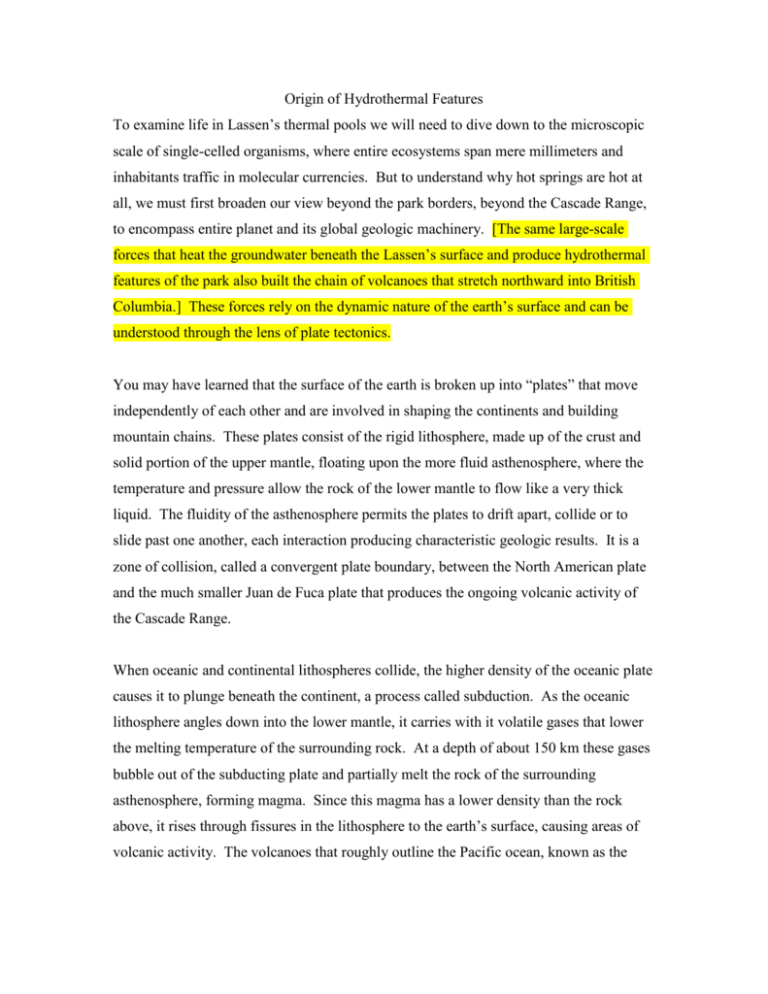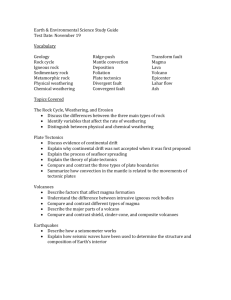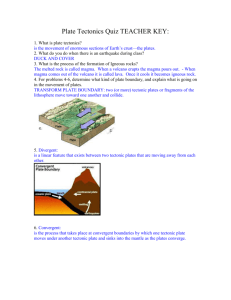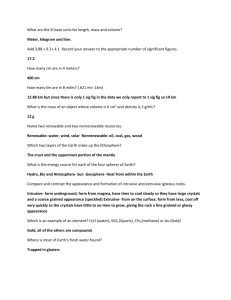To examine life in Lassen`s thermal pools we will need to dive down
advertisement

Origin of Hydrothermal Features To examine life in Lassen’s thermal pools we will need to dive down to the microscopic scale of single-celled organisms, where entire ecosystems span mere millimeters and inhabitants traffic in molecular currencies. But to understand why hot springs are hot at all, we must first broaden our view beyond the park borders, beyond the Cascade Range, to encompass entire planet and its global geologic machinery. [The same large-scale forces that heat the groundwater beneath the Lassen’s surface and produce hydrothermal features of the park also built the chain of volcanoes that stretch northward into British Columbia.] These forces rely on the dynamic nature of the earth’s surface and can be understood through the lens of plate tectonics. You may have learned that the surface of the earth is broken up into “plates” that move independently of each other and are involved in shaping the continents and building mountain chains. These plates consist of the rigid lithosphere, made up of the crust and solid portion of the upper mantle, floating upon the more fluid asthenosphere, where the temperature and pressure allow the rock of the lower mantle to flow like a very thick liquid. The fluidity of the asthenosphere permits the plates to drift apart, collide or to slide past one another, each interaction producing characteristic geologic results. It is a zone of collision, called a convergent plate boundary, between the North American plate and the much smaller Juan de Fuca plate that produces the ongoing volcanic activity of the Cascade Range. When oceanic and continental lithospheres collide, the higher density of the oceanic plate causes it to plunge beneath the continent, a process called subduction. As the oceanic lithosphere angles down into the lower mantle, it carries with it volatile gases that lower the melting temperature of the surrounding rock. At a depth of about 150 km these gases bubble out of the subducting plate and partially melt the rock of the surrounding asthenosphere, forming magma. Since this magma has a lower density than the rock above, it rises through fissures in the lithosphere to the earth’s surface, causing areas of volcanic activity. The volcanoes that roughly outline the Pacific ocean, known as the “Ring of Fire” were all born of subduction. Thus, the Cascades belong to the same volcanic arc as chains as far away as Japan and South America. Much of the volcanism in Lassen is, geologically speaking, quite recent. The majority of exposed rock in the Park is less than 5 million years old and Lassen Peak itself was formed only 11,000 years ago. Though considered dormant, Lassen Peak erupted as recently as 1917, and its placid surface belies the ongoing turmoil below. Magma chambers remain beneath the park at a depth of several kilometers slowing releasing heat and gases into the area’s groundwater. This water follows a general cycle, where rainwater and snowmelt percolate down through the rock until heated by the subterranean magma chamber. Note that the water never comes into contact with magma, for the energy radiated into the surrounding rock is sufficient to heat and even boil the groundwater. This thermally expanded water or steam push upwards through fractures in the rock, carrying along carbon dioxide (CO2), hydrochloric acid (HCl), and various sulfur compounds. This rising acidic mixture may cause the breakdown of surrounding rock by chemical weathering, further adding dissolved minerals to the solution on its way to the surface. Places where the liquid water has completely boiled to emerge from vents as steam are called fumaroles. This steam is mixed with a small percentage of the gases mentioned above, and when sulfur dominates the mixture the vents are known as solfataras. The temperature of emergent gases may range from just above boiling to 1000* C! Where heated water surfaces in liquid form we find hot springs. Hot springs may range from slightly warm to over 104* C. Water above 100* C is prevented from boiling by the minerals dissolved in it, just as adding salt to water raises the boiling temperature. The solutions may maintain high acidity, as well, ranging from [Range of pHs in hot springs] Hot springs often contain a high percentage of clay, taken from weathered bedrock. If the clay content is high enough in a hot spring, it is called a mudpot, though there is no formal line separating the two. All of these features may be found side by side in Lassen, notably in the active regions of Bumpass Hell and Sulphur Works in the southwest corner of the park. Beneath these features lies a large magma chamber, the remnant of the once great Mount Tehama volcano. It is important to note that any of these features may change over time. As summer drought saps the area’s groundwater, a bubbling hot spring may dry up, leaving behind a steaming fumaroles. On a much larger time-scale, geologic conditions may create or destroy whole regions of hydrothermal activity. Conditions vary even within a single hot spring; water may emerge from the vent nearly boiling, highly acidic and full of dissolved minerals but just meters from the source it can cool dramatically and precipitate out much of its mineral content. The dynamic nature of these hot springs environments poses yet another challenge to the microbes that reside there and it is to these that we now turn.









